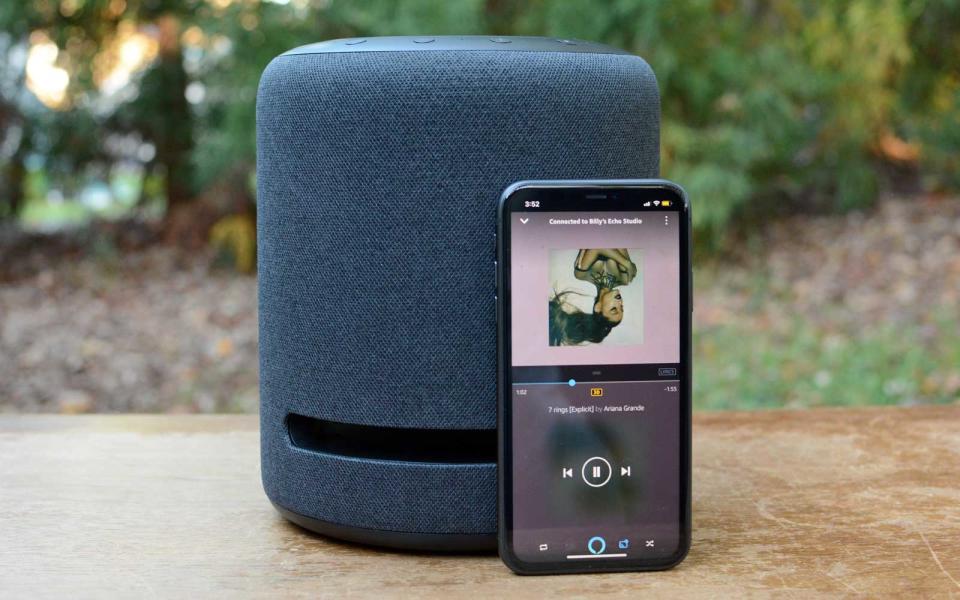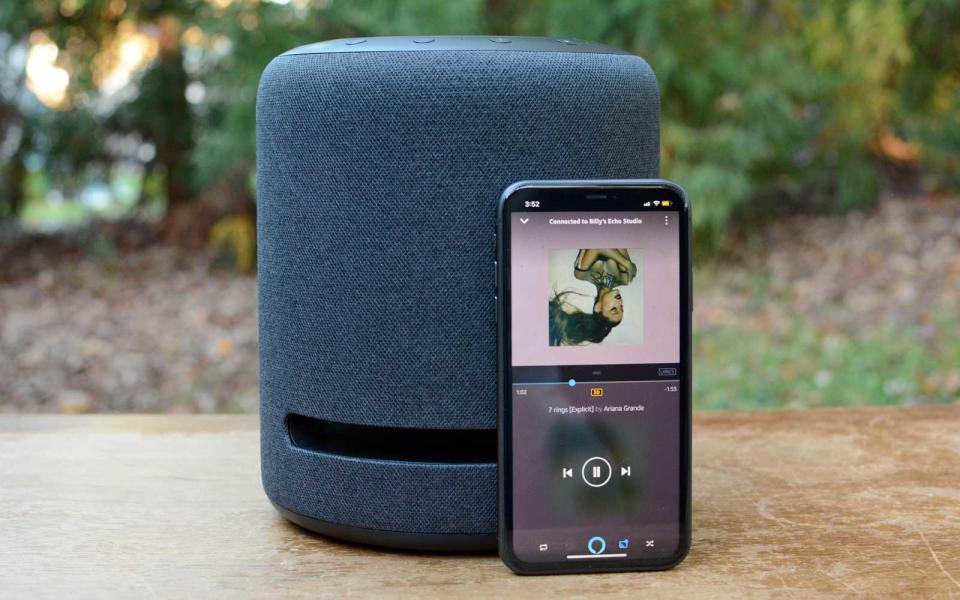Echo Studio review: Amazon finally nailed the audio quality
It’s pricier, but the sound quality is way better than the rest of the Echo lineup.
We've heard this pitch before from Amazon. Last year, the company debuted the $150 Echo Plus in an attempt to improve audio quality in its smart speaker line. It also revealed a $130 Echo Sub add-on that could provide the much-needed low-end tones that all of its Alexa speakers lack. But now that Amazon has a high-resolution option for music streaming, which also includes 3D audio, those older Echo devices just wouldn't cut it. Enter the $200 Echo Studio: a supersize Alexa hub that's hands down the best sounding speaker Amazon has built.
True to its heritage, the Echo Studio is indeed a capable Alexa speaker. That means a host of voice-friendly features are available here. The Echo Studio even has the same blue/green colored ring that lights up when you summon the virtual assistant. Or if you've disabled the speaker's microphones, the ring glows red. Through the Alexa app, you go through the initial setup and have access to customization options. At its core, the Echo Studio is everything we've come to expect from Amazon speakers, but the main differences here are size and sound.
Compared to other models in the Echo line, this thing is a beast. It dwarfs the latest Echo in every dimension. It's also larger than Apple's HomePod and the Sonos One, which is a better-sounding Alexa-compatible alternative to Amazon's devices. Like the HomePod, the Echo Studio is a short, stout cylinder. Specifically, it's eight inches tall (206mm), almost seven inches in diameter (175mm), and it weighs 7.7 pounds (3.5kg). None of this is a problem per se, but you will need more space to accommodate the Echo Studio than most competing devices. That's not to mention the fact that Amazon recommends six inches of clearance from walls.
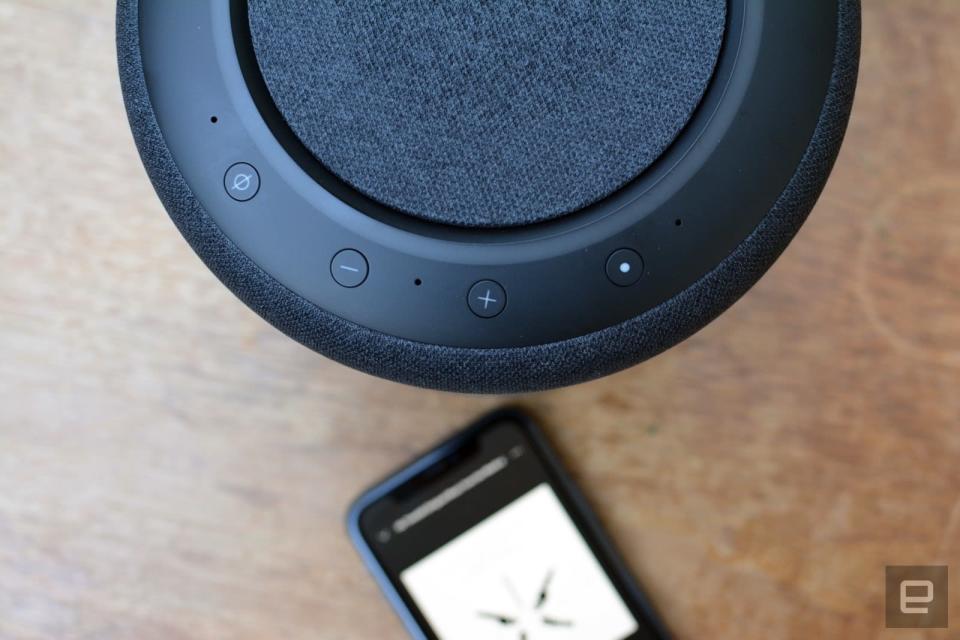
Despite its cylindrical design, the Echo Studio doesn't blast tunes in all directions. There are 3 two-inch midrange speakers that fire to the left, right and upward, respectively. A single one-inch tweeter faces forward, and a 5.25-inch woofer faces downward. There's an opening that spans the width or "belly" of the Echo Studio that enhances the bass output, and it's cut all the way through to the back of the speaker. However, if you move from the front or sides of this thing around to the back, it's clear there's no audio directly beamed in that direction. You can hear it; it just doesn't sound as good. Again, this isn't a major issue, just something to be aware of when you're positioning the unit.
There's also a 24-bit DAC (digital-to-analog converter) and an amplifier inside the Echo Studio -- key pieces that help the speaker handle high-res lossless content that's available through various streaming services, including Amazon's own. There are also a 3.5mm input for external audio sources and a micro-USB port flanking the power cable around back.
Like all other Echo devices at this point, the Echo Studio is wrapped in fabric. Except for the plastic ring around the top that houses controls and microphones, and a plastic plate on the bottom, almost the entire speaker is covered in cloth. I think it looks nice, and I prefer it to other smart speakers that are mostly plastic or primarily showcase exposed grilles as the main design element.
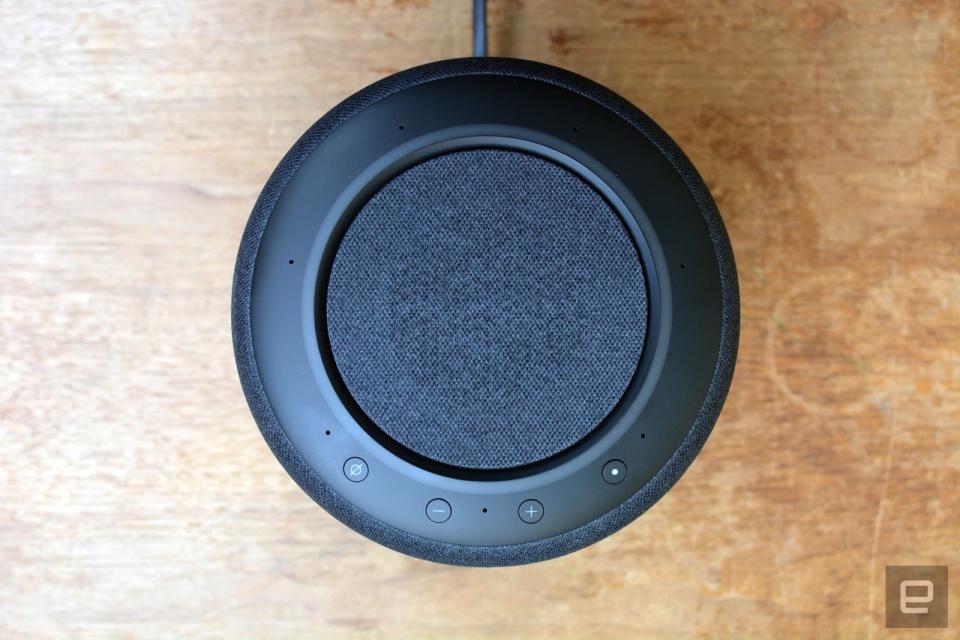
Once you've found a good spot, all you have to do is add the device to your Alexa app. A few taps later and the Echo Studio is set up and ready to go. There's an audio-calibration feature that analyzes the room for the best acoustic performance. However, that process begins automatically when you add the speaker in the app, and it only takes a few seconds. I wanted to test the Echo Studio both pre- and post-calibration, but that wasn't an option, since the test kicks in on its own.
The Echo Studio is the best speaker Amazon has made yet, at least in terms of audio quality. And really, it's not even close. Yes, every Echo speaker is capable of playing music, but it's no secret they don't sound good. So if great sound quality and Alexa support were both important to you, you had to look elsewhere or try to improve things with an additional purchase, like the Echo Sub. Those days are over.
To get the most out of this $200 device, you might want to consider Amazon Music HD or Tidal's high-res streaming plan. Sure, regular Spotify sounds good on the Echo Studio, but I prefer the HD and Ultra HD songs offered on Amazon's latest streaming tier. Other people I asked thought audio from Spotify sounded better. So I'd recommend using your free trial from Amazon to see if you're willing to pay for the higher-resolution audio or if just regular ol' streaming is enough for you. To me, there was more clarity, detail and dimensionality with the HD and Ultra HD songs when compared to the same tracks on Spotify.
The Echo Studio upmixed regular stereo music with Dolby Atmos. The action is enabled by default as Stereo Spatial Enhancement in the speaker's audio settings, right under the EQ sliders. Amazon says this upmixing "adds space, clarity and depth to stereo audio content." And of course, the company recommends that you leave it turned on "for best audio experience." When playing Chvrches' "Death Stranding" and switching the tool on and off, the main difference is that the nonenhanced audio from Spotify is louder and way more treble-heavy. With Stereo Spatial Enhancement, everything sounds well tuned and balanced. There is more depth and it does sound better, but it's not quite as good as HD and Ultra HD tracks.
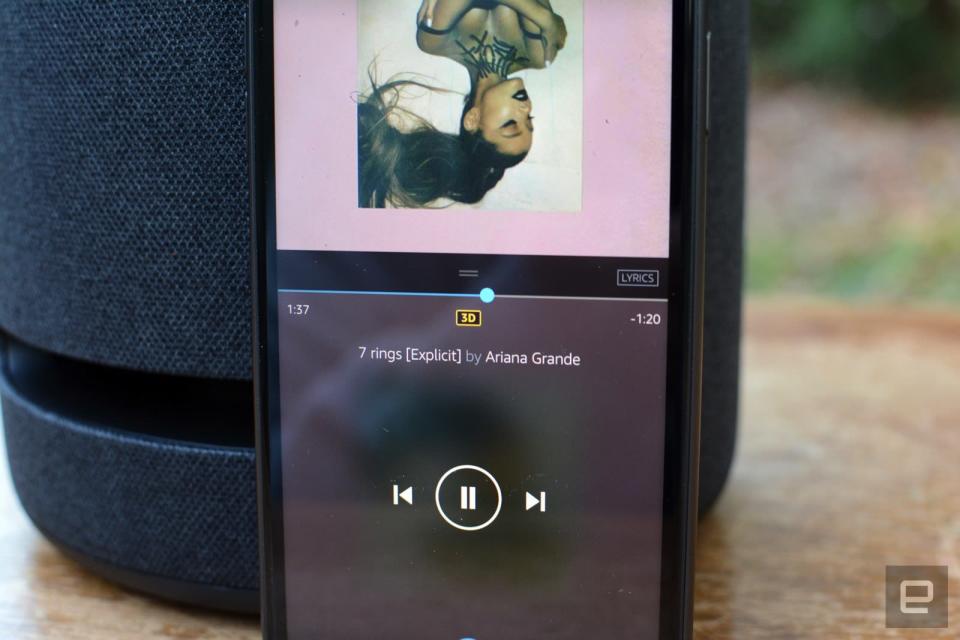
Spotify sounds good on this thing too, by the way -- I'm just stating my preference for the high-res options. If you're an Echo fan and you've been yearning for better audio, "regular" streaming tiers will sound great. However, Echo Studio is equipped to handle lossless tunes if you're into that sort of thing. The speaker is also able to handle Sony's 360 Reality Audio content, which is more of a mixed bag at this point.
The main issue with 3D music on Amazon Music HD is there's not much of it right now. When you set up the Echo Studio for the first time, Alexa recommends a Best of 3D Music playlist on Amazon Music HD. But that collection ranges from Ariana Grande's "7 Rings" to Cam'Ron's hip-hop masterpiece "Oh Boy" and the Beatles' "Lucy In The Sky With Diamonds." There are four more curated 3D playlists for rock, pop, classical and hip-hop classics, but they only have between six and 12 songs each. There are other 3D songs, but they aren't easy to find in the Amazon Music app, and I've yet to find any full 3D albums.
So what you end up with is a mix of 3D and either HD or Ultra HD when you pick an album. For example, the Weeknd's Starboy has ten 3D tracks, but the other eight are Ultra HD. When you ask Alexa to play music, the assistant will default to the 3D version if it's available. In fact, if a 3D version is available on Amazon Music HD, I haven't found a way to choose the Ultra HD or HD track instead. And of course, you can cast any songs from the streaming app to the Echo Studio, regardless of format.
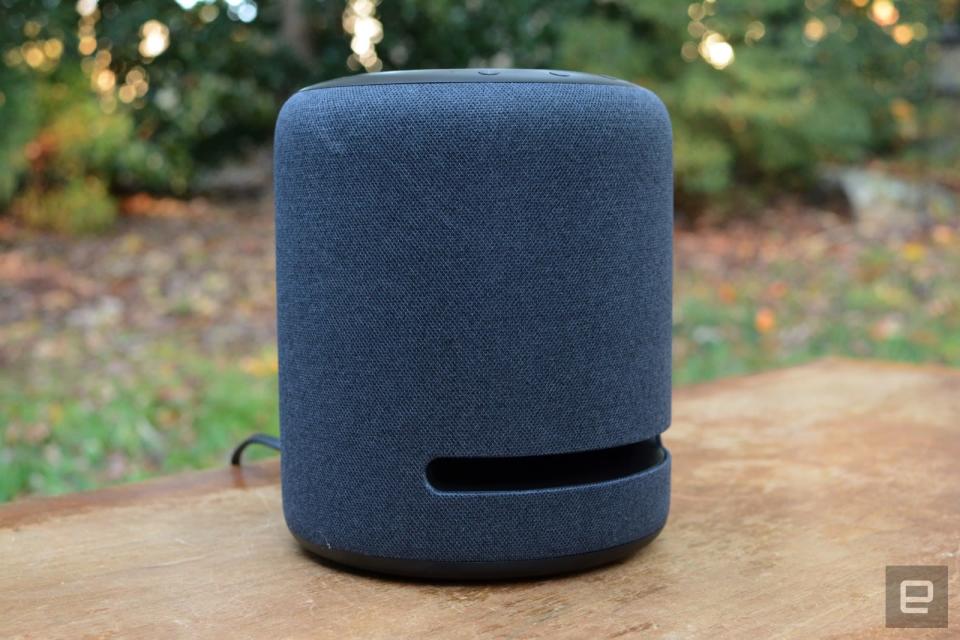
Honestly, I can't detect a huge difference between Ultra HD and 3D tracks on the Echo Studio. Unlike the prototype Sony speaker I heard at CES, it's still obvious the audio is coming from a single speaker and where the speaker is positioned. There isn't noticeably more depth compared to the other high-res formats, which also do a solid job imparting a spatial quality to the sound. When compared to Spotify, the 3D tracks have more presence and more clarity, which does sound better to me. They're also noticeably louder, even if you don't change that level. Once again, some people I asked preferred "regular" Spotify to the 3D versions of the songs I played for them.
That being said, it's still early days for this manifestation of 3D audio. This is the first speaker where Sony's new ecosystem has been available, and there are only 1,000 songs to choose from right now. The Echo Studio is well-equipped for both the present and the near future, so long as Sony is able to deliver on its promise of more content. And hopefully Amazon will make it easier to find them.
With Dolby Atmos compatibility, the Echo Studio can also serve as a home theater speaker, but only with Fire TV devices. It accommodates Dolby Digital and Dolby Digital Plus, if whatever you're watching isn't Atmos-friendly. Setup is a breeze once again: All you have to do is connect your gear to your Amazon accounts and WiFi network through the Alexa app. As with the initial steps for music, you tap the "+" in the top right of the Alexa app. But this time you select Set Up Audio System and follow the steps. In a few taps, the Echo Studio will be connected via WiFI for Fire TV sound. You can also use the Fire TV remote to adjust volume when the time comes.
I was only able to test this with one Echo Studio, not a stereo pair. While Atmos was clearly an upgrade over Dolby Digital Plus when I compared them, it's nowhere close to what I've experienced with Sony and Sennheiser Atmos soundbars and setups. Of course, those start at more than $1,000. There's more depth and subtle detail to things like city streets and gunfights. But like the 3D music, it's still obvious the sound is coming from a single speaker rather than seeming like it's all around you.
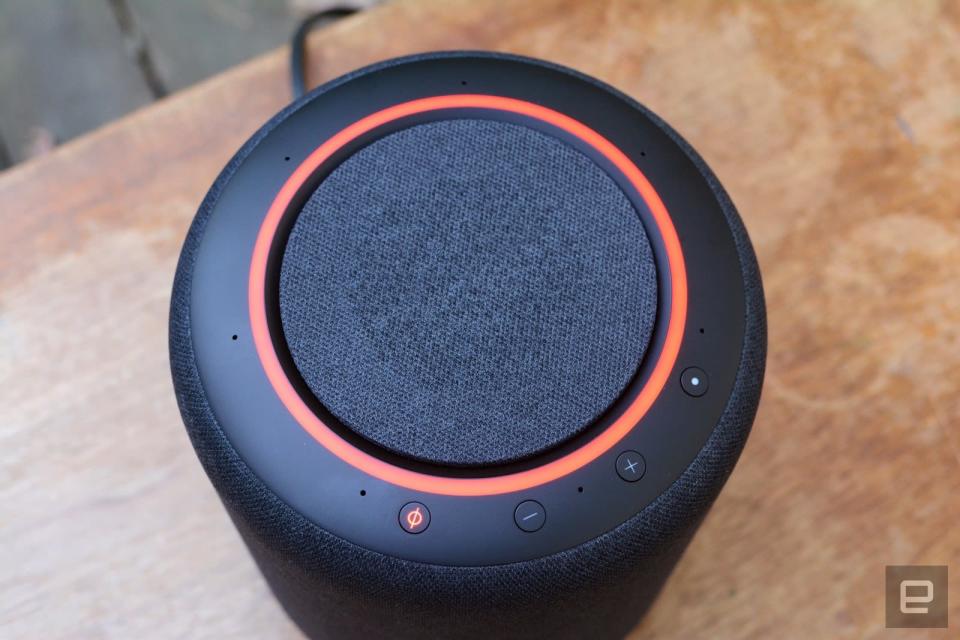
Again, the big issue here is limited content options. Pretty much the only thing available with Dolby Atmos on Prime Video is Jack Ryan. The other issue is the options aren't easy to find. And to get the immersive audio on Netflix, you have to splurge for the pricey Premium Plan that includes UHD streaming. Even then, not everything will have Atmos. Same for Disney+: A variety of selections, like Avengers: Endgame, have Atmos, but many others don't. Some rentals and purchases from Amazon offer the audio format too, so you have some options. But let's face it: We're living in a streaming-first world, so Prime Video should have more Atmos content, and it should be easily accessible and clearly labeled. Especially since Amazon is hyping the Echo Studio as an alternative to more-robust living room setups.
At $200, the main competition price wise is the Sonos One. There's also the HomePod, but it's $99 more expensive. Both are smart speakers with voice control, but neither sounds as good as the Echo Studio. In terms of audio quality, you'd have to go up to something like a Sonos Play:5 for an alternative that could stand with Amazon's latest. Of course, the Play:5 is $499. At that point, you could have two Echo Studio speakers for a stereo pair -- and still have $99 left over.
Amazon has finally built an Echo speaker for people who care about great sound but still want Alexa within speaking range. And both of those are in the same device rather than connecting an Echo Dot to a better speaker to get the audio quality you desire or some other workaround. Alexa remains dependable for the things it's equipped to handle, and the Echo Studio also makes a decent home theater option. My main issues using this device are the limited 3D content and how difficult it is to find both that and Dolby Atmos shows/movies in Amazon's apps. The speaker is great on nearly all fronts, but now Amazon needs to polish its software to offer a complete package.
